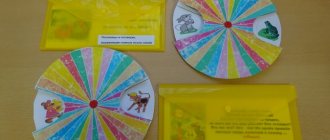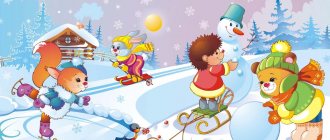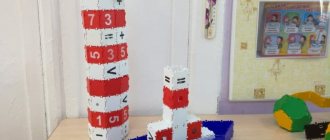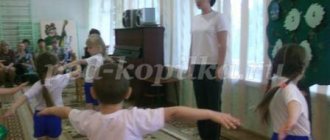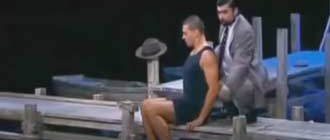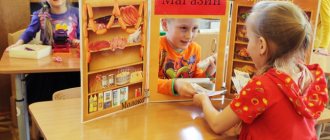Card index of thematic conversations on safety in the middle group
Card index of thematic conversations
September.
1 Week. (Goodbye summer! School).
1. Goodbye summer! School.
Goal: summarize and systematize
an idea of summer based on basic, essential features: length of day and night, temperature conditions, weather phenomena (thunderstorm, rainbow, lightning, state of plants (growth and flowering, ripening of berries and fruits, features of animal activity in the forest.
2. Day of Knowledge
Goal: To introduce children to the “Day of Knowledge” holiday. Form an idea of its origin.
Week 2. How we live in kindergarten
1. Subject
: Our favorite kindergarten
Goal: to form ideas about kindergarten employees, about the labor processes of each of them, the tools of their work; cultivate cognitive interest in the work of adults.
2. Rules of conduct in the garden area during a life safety walk
Goal: to teach children to follow the rules of safe behavior in the kindergarten area;
know the boundaries of your site;
remind them of the dangers that await them on the site.
Week 3. Alone at home. Dangers are all around us.
1. Dangerous items at home
Goal: to strengthen children’s understanding of objects dangerous to life and health, and the rules for using piercing and cutting objects. Consolidate knowledge about items that are strictly prohibited from using (matches, gas stove, stove, electrical sockets, switched on electrical appliances); about items that adults should store in inaccessible places (household chemicals, medicines, cutting and stabbing instruments)
. Develop knowledge that for safety, all objects must be put back in their place. Reinforce the knowledge that, if necessary, adults call by phone
«01»
,
«02»
,
«03»
.
2. Attention - fire!
Goal: Teach children to take the correct actions in case of fire.
To form public awareness of citizenship that carelessness can lead to fire.
3. Electricity
Goal: To teach children the correct actions during an emergency situation. Expand and deepen children's knowledge of fire safety rules. To develop in children basic knowledge about the dangers of pranks with fire (matches, electrical appliances, the dangerous consequences of a house fire.
4. Behavior in the kitchen
Goal: To teach children the correct actions during an emergency situation. Expand and deepen children's knowledge about the rules of behavior at home in the absence of parents. To develop in children basic knowledge about the dangers that await us in the kitchen.
Week 4. Take care of the forest
1. Let's go along the path into the forest
Goal: to awaken interest in the forest and its inhabitants; introduce the rules of behavior in the forest and the rules for collecting mushrooms; to arouse a desire to protect the forest and combat violations of the rules of conduct in the forest.
2. Flora in autumn
Goal: Expand the understanding of the diversity of the plant world. Learn to distinguish trees and shrubs by appearance. To form a desire to reflect the beauty of nature in artistic and creative activities.
3 Caution: mushrooms and plants in the forest, in the area for life and safety
Goal: to form a child’s understanding of the existence of poisonous plants and mushrooms; to introduce the plants of our site;
teach to distinguish between poisonous plants and mushrooms, give knowledge that a person can be poisoned by the poisons of these plants;
cultivate a caring attitude towards all mushrooms and plants.
Week 5 Red Book of the Earth
1. Red Book, red means nature is in danger
Goal: Continue to introduce children to the Red Book and its purpose.
Expand children's horizons and interest in nature.
Related questions:
2. We are friends of nature, life safety
Goal: To consolidate children's knowledge about the rules of behavior in nature. Teach caring and kind attitude towards nature and each other.
October.
1 Week. Autumn is golden.
1. Sky in autumn
Goal: To be able to notice autumn changes in the sky. Introduce children to the concepts of “clouds” and “clouds”.
2. At the flower bed
Goal: Getting to know autumn colors. Show the structure of the plant. Reinforce the concept of high, low (flower, long, short (stem)
.
3 Canteen duty
Goal: to teach children how to set tables correctly and safely for themselves and others; follow safety rules when handling knives and forks; consolidate the idea of dangerous objects and their necessity for humans.
Week 2: Harvesting
1. What has autumn brought us?
Goal: Expand children's understanding of vegetables and fruits. To consolidate knowledge about seasonal changes in nature. Give an idea of the benefits of natural vitamins.
2. Where can I play? life safety fundamentals
Goal: To form the idea of younger preschoolers about safety on the streets and roads. Convince children of the dangers of playing on the roadway (road)
. Explain why you can’t play on the street and roads. Designate places for games and riding scooters, children's bicycles, skis, sleds and ice skates.
3. Basket of mushrooms
Goal: to cultivate in children an interest in the life of the forest, an understanding of the need to preserve its integrity, and the ability to behave in the forest; contribute to the deepening and generalization of children’s existing ideas about living nature, expand children’s ideas about the forest and its inhabitants; learn to identify parts of a mushroom (leg, cap, root, recognize mushrooms, say their names, classify mushrooms based on edibility (edible - inedible)
.
Week 3. Children of the forest: mushrooms and berries.
1. Forest hazards life safety
Goal: Expand children's understanding of poisonous plants. Learn to distinguish them by appearance.
2."Kaleidoscope of autumn colors"
Goal: to consolidate ideas about changes in nature in autumn, about fruits, vegetables, berries, mushrooms, to create a joyful mood in children, to evoke emotional responsiveness, and the ability to develop interest in the world around them.
Week 4 Who grows our bread
1. Where did the bread come from?
Goal: to consolidate children's knowledge about bread as one of the greatest riches on earth. Tell the children how bread appears on our tables, what a long journey it travels before we eat it.
2. Take care of your bread
Goal: To cultivate a caring attitude towards bread. Learn how to handle bread correctly.
3. Getting to know the street OBZH
Goal: To familiarize children with the street and its features, to reinforce the rules of behavior on the street; walk only on the sidewalk; on the right side; cross the street only through an underground passage or zebra crossing
.
Week 5. Autumn. People's work in autumn.
1. Conversation
about people's work in autumn
Goal: systematize
knowledge about people’s work in the fall: harvesting, preparing food for the winter, insulating the homes of pets; learn to establish the reasons for changing types of work, compare them with the work of people in the summer, draw conclusions about the direction and meaning of work; enrich the vocabulary by introducing words: harvesting, harvesting, granary, vegetable storage, canned food, wintering; to cultivate respect for people’s work and the desire to help them.
2 Autumn
Goal: expand children’s understanding of the characteristic signs of autumn; teach to find them in nature; clarifying ideas about the changes that occur in autumn in the life of plants. Learn to establish connections between the length of the day, air temperature, the condition of plants, and the availability of food for animals. To cultivate cognitive interest, a careful and aesthetic attitude towards nature, sensitivity to the perception of the beauty of the autumn landscape.
3. Conversation
about migratory birds
Goal: To consolidate knowledge about seasonal changes in nature. Give an idea of migratory birds. Learn to distinguish and name birds by external features. Create a desire to observe the behavior of birds.
4 Safety regulator
Goal: to introduce children to the profession of a police officer and the work of the traffic police.
November.
1 Week. My village.
1. My home, my village
Goal: To consolidate knowledge about home address, street. Get to know your native village.
2. It’s not time – don’t leave the life safety yard
Purpose: To explain to children that they cannot play near roads.
2. week “My native land”
Goal: To form initial ideas about the native land, its history and culture. Cultivate love for your native land.
2. “We’re going on an excursion (walking tour)
»
(OBZH)
Purpose: to provide knowledge about safety rules during walking excursions,
teach to comply with safety requirements.
Week 3 Moscow is the capital of our Motherland
1. Holidays
Purpose: To form an idea of public holidays.
2. We love holidays in d/s life safety
Goal: to introduce children to the rules of behavior during celebrations on the street; develop safe behavior skills; cultivate mutual respect and good feelings.
3. Moscow is the capital of our Fatherland
Goal: to give children an idea that Moscow is the largest city in our country; bring to the understanding that this is the main city of our Motherland, the capital. Foster respect for state symbols, traditions and customs of your people. To cultivate a love for Moscow and Russia in general, broaden one’s horizons, pass on knowledge about history and sights. Foster a sense of pride for your people, patriotic feelings.
Week 4. State symbols of Russia
Goal: To familiarize children with the image of the national flag, the state emblem of the Russian Federation, and the national anthem. Form an idea of their origin.
2 Beware - strangers! life safety fundamentals
Purpose: To prevent children from troubles associated with contact with strangers. To promote the development of caution and prudence in communicating with strangers.
December.
1 Week. Winter has come.
Goal: Expand children's understanding of winter phenomena in nature. Give basic concepts about the relationship between man and nature.
2. “The frosts are severe this year” (OBZh)
Goal: to teach how to behave correctly in frosty weather.
4. "Winter phenomena in nature"
Goal: Expand ideas about winter changes in nature. Activate vocabulary (blizzard, hoarfrost, frost)
.
Week 2. Animals of the North
1 Wild animals of the North
Goal: to continue to introduce children to the appearance of wild animals. Give the idea that all animals have thick, dense fur, so they are warm even in severe frost. Tell children about the habits of animals in the North and what they eat.
Instill a love for animals.
2. Animals of the Arctic and Antarctic
Goal: Expand ideas about places where it is always winter, about animals of the Arctic and Antarctic.
3. Be careful of icicles and snow from the roof.
Objectives: to provide knowledge that icicles can be dangerous to humans (if they fall from the roof - injury and remember, if licked or eaten - sore throat);
teach how to protect yourself from icicles at the end of winter and beginning of spring, obey safety rules, and be able to anticipate danger.
Week 3. How do wild animals spend the winter?
How wild animals prepare for winter
Goal: To introduce children to preparing wild animals for winter. Show children the adaptability of animals to seasonal changes in nature.
2. Wintering birds
Goal: To consolidate the concept of “wintering”
birds. Give an idea of the types of food of wintering birds. Develop a desire to take care of wintering birds.
3 Ice life safety
Goal: know the safety rules in winter - in icy conditions;
know from pictures
identify a dangerous situation;
describe it, and the rules that must be followed so as not to get
injury and not die.
Week 4. New Year's holidays!
1 New Year is at the gates!
Goal: To consolidate children's knowledge about New Year traditions. Awaken emotions and feelings in situations of magic, surprise, unexpectedness.
3. Travel on New Year's Eve
Purpose: To inform children that the countdown of each year begins on January 1. Form an emotionally positive attitude towards the coming new year.
4. About the rules of the road life safety
Goal: to teach children to correctly name the elements of the road; introduce the rules for driving on the side of the road; consolidate knowledge of familiar traffic rules
January.
1 Week. The winter vacation
Week 2. Winter fun.
1. Who feels good in winter?
Goal: To engage children in casual conversation
about winter fun and activities.
2 Winter life on the hill
Purpose: to teach children to obey the rules of behavior when sliding downhill;
Develop endurance and patience - the ability to wait your turn;
develop a desire to avoid traumatic situations.
3. “Winter sports”
Purpose: To introduce winter sports.
Week 3. Properties of objects.
1. "In the world of glass"
Purpose: To help identify the properties of glass. Cultivate a caring attitude towards things.
2. Why did the Snow Maiden melt?
Goal: Expand children's understanding of the properties of water, snow and ice
4. Rules of conduct in transport life safety
Goal: To consolidate children’s knowledge about the rules of behavior in transport
Week 4. Houseplants
1 World of indoor plants
Goal: Expand children's understanding of indoor plants: their benefits and structure. Learn to distinguish by appearance.
2. Labor activity life safety
Goal: to teach children to observe safety rules when using objects and tools during work activities (watering cans, rags, sticks - work in a corner of nature; stacks, scissors, pencils, brushes - manual labor; rakes, spatulas, scoops, brooms - work in nature).
Week 4 Winter. People's work
1. Injury: how to avoid it? life safety fundamentals
Goals: Continue to learn how to provide all possible assistance in case of injury; cultivate a sense of mercy and compassion; teach how to behave correctly at home and on the street; avoid injury
2. Firefighter
Goal: To expand and strengthen children’s knowledge about the firefighter profession, to cultivate respect for people of heroic professions, and to reinforce fire safety rules.
February
1 week Road traffic. Transport.
1 Transport of my city, village
Goal: Expand understanding of types of transport and their purpose. Develop skills of cultural behavior in public transport
2. Road safety life safety
Goal: to remind children about the rules of behavior on the roads
Week 2 Building a house
3. About the profession of firefighter
4. Goal: to expand and consolidate children’s knowledge about the profession of firefighter.
5. Intensify children's interest in various professions. Pin
6. fire safety rules. Cultivate respect for people
7. courageous and heroic professions
8. About the profession of builders
9. Goal: expand ideas about the construction profession.
10. Summarize knowledge about construction professions; show significance
11. construction professions. Cultivate a respectful attitude towards
12. a working person.
February1 week. Road traffic. Transport.
1 Cars - helpers
Goal: Expand understanding of types of special transport and their purpose
.2 Winter roads life safety
Goal: to expand children’s knowledge about the rules of behavior on the street and the road in winter.
Give children knowledge that in winter the roads are slippery and drivers cannot move quickly.
stop the vehicle. On slippery roads, cars and buses even
After braking, they slide forward for some time. Cultivate the ability to restrain
yourself, be careful, don’t play on the road.
Week 2. We are building a house.
1 Getting to know the street OBZH
Goal: To familiarize children with the street and its features, to reinforce the rules of behavior on the street; walk only on the sidewalk; on the right side; cross the street only through an underground passage or zebra crossing
.
2 What distinguishes a city from a village
Goal: To form basic ideas about the differences between a city and a village. Instill love for your native land. Foster a sense of pride in your city.
Week 3. Defenders of the Fatherland.
1 Our army
Goal: To expand knowledge about the difficult but honorable duty to defend the Motherland, to protect its peace and security.
2 Cossacks - defenders of the Fatherland
Goal: To develop in children an interest in the heroic past and present of their Fatherland. To develop the qualities necessary for future defenders of the Fatherland. Foster love for your small homeland, a desire to learn more about the life of your ancestors
3 Look left, look right Life safety
Goal: To consolidate children's knowledge of how to cross the road correctly.
4. Future defenders
Goal: To foster patriotic feelings. To form in boys the desire to be strong, brave, to become defenders of the Motherland.
Week 4. All works are good
1. "Our hardworking janitor"
Purpose: To introduce children to the work activities of a janitor, to show the importance of work; cultivate a desire to maintain cleanliness and help adults.
2. Assistant teacher
Purpose: To draw children's attention to the most typical labor operations and the result of the work of an assistant teacher. Cultivate respect for his work.
3. "Visiting a laundry worker"
Goal: To develop the ability to understand the social significance of the laundress’s work, her caring attitude towards children. Emphasize that the result is achieved through a conscientious attitude to work. Cultivate a positive emotional attitude towards the laundress.
4 My traffic light friend OBZH
Goal: To acquaint children with the basic rules of street traffic, tell them what irreparable consequences a violation of traffic rules leads to.
5. "Visiting the music director"
Purpose: To introduce the business and personal qualities of a music director. Develop an emotional, friendly personality.
March.
1 Week. Different mothers are important!
1 Congratulations to our mothers on the spring holiday"
.Goal: Read poems about mother, grandmother and sister. Cultivate a sensitive attitude towards those closest to you.
2 What does my mother do?
Goal: To cultivate interest in various professions, paying special attention to the profession and place of work of the mother.
3 Health and safety doctor
Goal: To continue to cultivate a friendly attitude towards the medical profession, to familiarize with its necessity and benefits
Week 2. Folk doll toy
1 How to celebrate Maslenitsa
Purpose: To introduce the Maslenitsa holiday. Expand knowledge about folk traditions
2. "Folk toy"
Goal: Expand the understanding of folk toys. To develop the ability to express aesthetic feelings. Expand the understanding of the diversity of folk art.
3. "Acquaintance with the Russian folk doll"
Goal: To introduce Russian folk crafts and traditions. Arouse interest in Russian folk art and handicrafts.
4 How to behave in a life safety group
Goal: to educate children in the rules of behavior and communication in the kindergarten premises
(in the group, bedroom, reception room)
. Develop the ability to obey rules
safety, desire to protect your health and the health of others
Week 3. Animals of hot countries.
1. Animals of hot countries
Objectives: Clarify with children the names of animals in hot countries and their babies; clarify external signs, their structure, what they eat. Improve the grammatical structure of speech (form possessive adjectives, compound words)
.
1 You find yourself alone away from home! life safety fundamentals
Goal: To teach children the correct actions during an emergency situation
Week 4. Birds are our friends.
1. Return of feathered guests
Goal: To consolidate knowledge about migratory birds, their appearance and names
2 Birds
Purpose: To become familiar with seasonal changes in the life of birds in the spring. Learn to distinguish and name birds by external features. Create a desire to observe the behavior of birds.
3 Forest hazards life safety
Goal: Expand children's understanding of poisonous plants. Learn to distinguish them by appearance
April.
1 Week. Spring came.
1. "Spring is coming! Spring is dear!
Goal: Expand the idea of spring. Develop the ability to establish spatial connections between living and inanimate phenomena.
2 The cat and the dog are our neighbors. life safety fundamentals
Goal: to explain to children that contact with animals can sometimes be dangerous;
learn to take care of your safety.
Week 2. Space.
1 First cosmonaut
Goal: to continue to acquaint children with the feat of Yu. A. Gagarin and its significance for humanity. Develop cognitive interest in space as an object of the surrounding world.
2. "Space"
Goal: to develop in older preschool children ideas about outer space, the solar system and its planets, and human space exploration.
3 Moving around the kindergarten
Goal: to teach children the rules of safe movement around the kindergarten;
Cultivate self-control, the desire to consciously behave correctly in
room d/s.
Week 3 Nature is our home
1. Save water
Goal: To develop in children a conscious, careful attitude towards water as an important natural resource, that is, to develop environmental awareness. Identification of clean water leaks and practical actions aimed at conserving clean water supplies.
2 On a visit to the owner of the meadow OBZH
Goal: To foster a caring attitude towards nature. Expand your understanding of the rules of safe behavior in nature
3 Take care of nature
Goals: expand children’s understanding of the flora and fauna, develop the ability to observe, analyze, and develop logical thinking. To cultivate love for one’s native land and the ability to behave correctly in nature. Give children an idea of how people care about nature and love it. Foster a caring attitude towards the forest and a desire to do good deeds.
Week 4. Planet Earth.
1 Planet Earth is in danger
Goal: to promote the formation of children’s ideas that planet Earth is a huge ball (most of the globe is covered with water - oceans and seas, in addition to water there are continents - solid earth, land where people live). To contribute to the generalization of knowledge that many living creatures live on planet Earth, that they all need clean water, clean air, clean land. To form the idea in children that planet Earth is now in danger. To cultivate a love for nature, proper communication with it, a desire to study it.
2."Voices of the Planet"
Goal: To develop observation and curiosity.
Cultivate an interest in the life of the planet, a desire to preserve and protect its nature.
3. How sand can become dangerous to life safety
Goal: show the child games with sand and warn him that playing with it is unsafe: you need to be careful and make sure that sand does not get into your eyes, mouth, nose, or clothes.
Week 5 Insects.
1 Insects
Goal: continue to introduce children to insects - butterfly, ant, bee (appearance, habits, reproduction)
and give ideas about the relationship of any living organism with its environment.
Activate the vocabulary (notches, pollen, nectar, cells, honeycombs)
. To cultivate love and respect for all living things; develop logical thinking.
2 “Insects - benefits and harm” (OBZh)
Purpose: to provide knowledge about the rules of behavior when meeting different insects.
May.
1 Week. Victory Day!
1. Victory Day holiday
Goal: to continue to acquaint children with the history of their country, with the defenders of the Fatherland. To consolidate children's knowledge of how Russian people defended their Motherland during the Great Patriotic War. Develop children's speech and thinking, the ability to argue their statements.
2 Kuban is our Motherland
Goal: to continue acquainting children with the history of their native land during the war of 1941-1945. To cultivate a caring attitude towards people's memory, a feeling of gratitude towards veterans of the Great Patriotic War. To form an awareness of the essence of the concept of Motherland as the place where a person was born. Fostering love for the Motherland, interest in its heroic history; formation of a sense of pride in warrior-defenders.
7. How to behave during outdoor games? life safety fundamentals
Goal: to teach the ability to control your behavior: restrain yourself and listen
to the opinions of others, to improve oneself as a person through communication with people; learn
coordinate your actions with the actions of your partner.
Week 2. Flowers.
1 Trees, shrubs and herbaceous plants
Goal: Expand ideas about changes in the plant world in spring. Learn to distinguish trees and shrubs and flowers by appearance.
2 How to behave in the heat on the site? life safety fundamentals
Goal: to teach children to put on a hat without prompting from adults, to reinforce the ability to correctly pour water from a kettle into a cup, to follow the rules of being in the sun so as not to overheat.
4 Blooming spring.
Goal: To generate interest in the world of plants. Reinforce ideas about plant habitats
5 Flowers.
Purpose: to give an idea of what a flower is. Teach children to classify flowers according to where they grow. Note the significance and role of flowers for the life and activities of humans, animals, and insects. Learn to recognize garden flowers from wild and forest flowers.
Week 3. Summer.
1 Summer.
Goal: summarize and systematize
an idea of summer, summer plants and animal activity at this time of year; clarify the idea of some types of agricultural labor in the summer. Develop coherent speech, the ability to speak clearly; cultivate a desire to share your knowledge and memories with peers.
2 Garden and vegetable garden
Goal: To form basic ideas about garden and vegetable plants. To form ideas about seasonal work in the garden and vegetable garden. Instill a love of work.
4 Rules of behavior on the water. life safety fundamentals
Goal: to introduce children to the rules of behavior on water in the summer.
Summary of a lesson on life safety in the middle group plan-summary of a lesson on life safety (middle group) on the topic
Summary of a lesson on life safety in the middle group
Lesson notes for the middle group “Dangers around us.”
Goal: to develop conscious safe behavior in children in life and everyday life.
Objectives: - consolidate knowledge about the sources of danger and their consequences; - develop memory, attention and ingenuity; - cultivate a sense of empathy; - expand children's vocabulary. Preliminary work: Conversations, games - dramatizations ("The Wolf and the Seven Little Goats" ...), with a good ending, examination of illustrated material, reading works of art "Cat's House" by S. Marshak, "Confusion" by K. Chukovsky, “Once upon a time there lived a baby elephant” by G. Tsyferov. Material: plot pictures from life, dangerous objects (matches, nails, scissors, pins, needles, hammer, awl, knife, fork) and safe objects (toys), Carlson doll, toy telephone.
Progress of the lesson.
The children are sitting in a semi-circle. Teacher: - Guys, someone is knocking on our door, look, Carlson has come to us, for some reason he is dirty and has no shoes.
Educator: Do you want to know what happened to him? (Yes) Now I’ll ask him, what happened to him? OK. Carlson, don’t worry, sit with us. (I turn the picture to the children.)
Educator: - Here, guys, look what happened to him. Carlson decided to heat up dinner in the kitchen, turned on the gas stove and went into the room to watch TV. He was watching his favorite cartoon “Masha and the Bear,” and at that time the towel that was lying next to the stove caught fire and started a fire. When Carlson flew to his roof, everything there was burning.
Educator: - What do you think Carlson started doing? (That’s right, he ran back into the room and started calling people for help).
Educator: - Who came to help?
Educator: - What would happen if he hid under the sofa, under the table, in the closet? (You cannot hide in the far corners of the room; not only fire, but also smoke is dangerous.)
Educator: - What did Carlson do wrong? (He turned on the stove and went into the room.)
Educator: - Why did the fire happen? (The stove was on and the towel caught fire.)
Educator: - What rule should children always remember?
Educator - That's right, children should not turn on electrical appliances: tiles, iron, TV. This should be done by adults. Children should not play with matches. Matches are not toys. And you were right in telling me that Carlson should not have hidden if there was a fire at home, he should have called for help, which he did. If you hide, it will be very difficult for firefighters to find you. Educator: Well done, guys!
Educator: Now guys, let's remember what dangers may still lie in wait for us? And our guest invites you to play with him and learn to behave in such a way that trouble does not happen. Physical education minute:
Game “Do's and Don'ts” I will roll the ball for you and ask you questions, and you will answer whether you can or not. 1. Can I play with matches? 2. Do you stick your fingers into sockets? 3. Do you want to play with toys in the corner? 4. Read books at the table? 5. Maybe you can play with doors? Close and open? 6. Should you take sharp objects? 7.Knit together with your grandmother? 8. Should I bring some medicine to the kindergarten and give the kids a treat? 9. Play quietly on the carpet if the soup is hot on the table? 10. Take scissors without asking and poke your neighbor? Educator: Guys, I would like to know from you what you will do if: An adult persuades you to go somewhere with him, promising to give him a toy, candy, or show him something interesting. (That’s right, under no circumstances should you go anywhere with strangers)
Educator: What if an adult opens the car door and invites you to go for a ride (this is life-threatening, of course you can’t)
Educator: Suddenly an adult treats you with candy, ice cream, or gives you a toy. (You can’t take anything either, the toy can be dangerous, and in general you shouldn’t take anything from someone else’s hands)
Educator: Well done guys, you tried. And Carlson learned a lot in our lesson and wants to play with you.
Educator: Finally, I would like to explain to you, when there is trouble, where to call.
Fire service telephone number – 01
Fire and smoke from all sides, We urgently need a phone. Dial simple numbers and give the exact address (children dial the number on the phone)
If you are in trouble, dial phone 02. The police will come to you, help everyone, save everyone. (children dial a number on the phone)
If a person feels bad
There's no point in sighing and groaning,
Dial the number urgently
Ambulance 03 (children dial the number on the phone)
Educator: and now, summing up the lesson, I want to ask you. Will you talk to strangers? How about playing with matches? In case of fire, hide under the bed.? Guys, tell me, is it possible to light the stove yourself and leave it alone? (No.) . Did you remember the assistants’ numbers? (yes)
Educator: what a great fellow you are! Carlson, thank you for stopping by to visit us; using his example, he taught the children how to behave in case of a fire. Goodbye, see you again. Guys, thank you for your active participation in our lesson today.
MAGAZINE Preschooler.RF
Summary of a lesson on life safety in the middle group “Beware of ice”teacher Vakhitova N.A. G. Yugorsk 2022 MADOU “general developmental kindergarten “Guselki”
Program content:
- Give children an idea of ice as a natural phenomenon.
- Introduce children to the concepts of “slippery road” and the peculiarities of transport on it; with a slippery road .
- To instill in children a conscious attitude towards compliance with traffic safety rules.
Vocabulary work: ice.
Methodological techniques: artistic expression, conversation, questions of a cause-and-effect nature, creating a problem situation, conducting an experiment.
Preliminary work: excursion to the road, observing its changes depending on weather conditions; conversations about traffic rules, reading the poem “Ice” by I. Leshkevich.
Progress of the lesson.
Educator.
-Guys, we live in the beautiful city of Yugorsk. Our city is especially beautiful in winter: there is a lot of snow all around, the trees are covered with silvery frost. Cars move along the wide snow-covered streets, buses drive, pedestrians walk along the sidewalk, and no one bothers anyone, because everyone follows the traffic rules.
Didactic game "Good-bad" .
-Guys, tell me good and bad - “winter” (good - a lot of snow, children make snow buildings; bad - traffic jams, drifts on the roads)
“Ice is good” (skating, playing hockey, winter fishing, ice for ice cream in the summer; bad – accidents on the roads, people falling).
(The teacher displays several pictures)
- Guys, what do these pictures have in common? (they depict road accidents).
-What do you think caused the accident? (children's answers).
-What is ice? Why does ice form? (children's answers)
Reading the poem "Ice"
It's frozen in the morning, there's no warmth from yesterday, there's ice on the roads, and everything is carrying cars.
The sidewalks are like a skating rink, I could take another step, but the soles let me down, they are very slippery.
How much trouble there is from ice! There is a job for the janitors - to pour salt and sand so that pedestrians can pass.
Educator: Winter is the most dangerous period for drivers and pedestrians. Why guys? (the number of accidents increases; if there is wind outside, the temperature is zero, ice appears on the roads; cars on a slippery road are much more difficult to brake than on dry asphalt)
-Guys, many of you have traveled with your dad by car more than once. How should dad drive the car to avoid skidding on the road? (move at a low speed, keep a distance between cars, avoid sharp braking when turning, turn the steering wheel smoothly, drive with headlights on).
Physical exercise.
It's snowing, it's snowing The janitor is sweeping the street, The janitor is sweeping the street, People are walking on the side.
Educator: Pedestrians in icy conditions should also be attentive and careful. When going outside, pay attention to your shoes: the soles should not be slippery)
-How should you move along the road? (you need to look at your feet, try to avoid dangerous places; in icy conditions you need to move like a skier with small sliding steps, since your legs move apart and if you lose your balance, a bruise, dislocation or fracture is guaranteed; to maintain balance, your hands must be free, do not keep them in your pockets).
Well, if a fall occurs, what should you do? crossing the road in front of nearby traffic is dangerous.
Reading a poem
There is ice on the road. Stop! Attention people! Dear pedestrians, Place your feet carefully!
And it is especially dangerous if there is transport nearby. A speeding car cannot brake quickly.
On ice the wheels are not obedient. You need to know and remember this. Attention and caution. They will help you in case of ice.
-How do road services help in icy conditions? (they clean the roads, sprinkle sand on slippery roads.
Educator: Today we got acquainted with the road sign “Slippery road” , and to better remember this sign, draw it on a piece of paper.
Children draw on their own.
| Next > |
